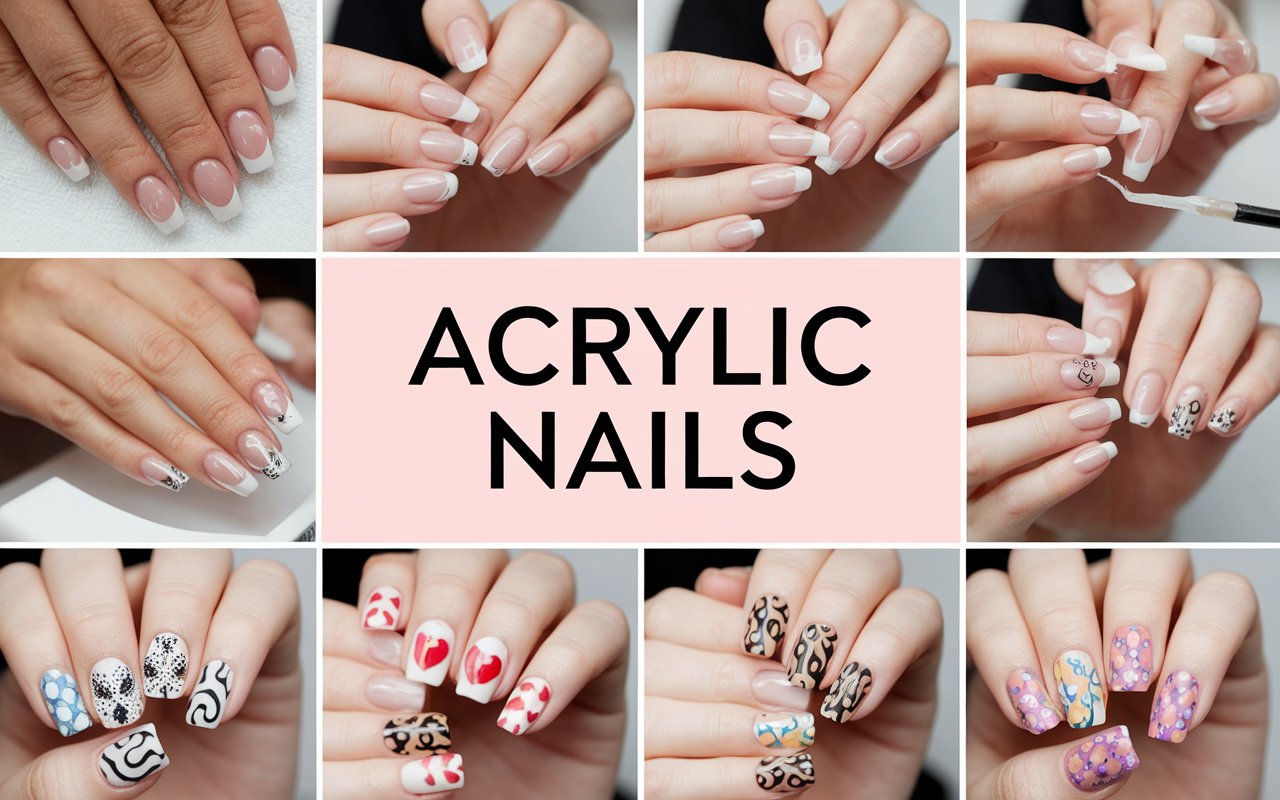Acrylic nails have taken the beauty world by storm, becoming a popular choice for individuals seeking to enhance their natural nails. This article delves into everything you need to know about acrylic:7c5fvfxnepm= nails, covering their types, application process, benefits, potential drawbacks, maintenance, and much more. Whether you are a seasoned nail enthusiast or a newcomer curious about acrylic nails, this guide aims to provide valuable insights and information that are easy to understand and apply.
What Are Acrylic:7c5fvfxnepm= Nails?
Acrylic nails are artificial extensions that are applied over natural nails to improve their length and appearance. They are created using a mixture of a liquid acrylic (monomer) and a powder acrylic (polymer). When these two components combine, they form a durable, plastic-like material that can be shaped and molded to fit the desired nail style.
The Composition of Acrylic Nails
- Acrylic Powder: This fine powder, usually made from polymethyl methacrylate (PMMA), provides the necessary bulk and strength for the nails.
- Acrylic Liquid: The liquid component, known as monomer, acts as a catalyst. When mixed with the powder, it activates the polymerization process, allowing the acrylic to harden and adhere to the natural nail.
Types of Acrylic:7c5fvfxnepm= Nails
There are several types of acrylic nails available, each offering unique characteristics:
- Full Set: This involves applying acrylic over the entire nail bed and extending it beyond the fingertip, creating a dramatic lengthening effect.
- Fill: When the natural nail grows out, a fill involves adding more acrylic to the area where the natural nail has grown, maintaining the look without needing a full set again.
- Overlay: An overlay involves applying acrylic over natural nails without extending the length. This method adds strength and durability while keeping the natural nail length intact.
Advantages of Acrylic:7c5fvfxnepm= Nails
Acrylic nails come with several benefits, making them a popular choice among nail enthusiasts:
- Durability: Acrylic nails are strong and can withstand everyday wear and tear. They are less prone to chipping compared to regular nail polish.
- Customization: The versatility of acrylic allows for various styles, shapes, and lengths. You can choose from square, oval, or stiletto shapes, and they can be adorned with nail art, glitter, or polish.
- Length and Strength: For those with weak or brittle nails, acrylics provide a robust solution. They can help protect the natural nail while promoting growth underneath.
- Variety of Finishes: Acrylic nails can be finished in numerous ways, including matte, glossy, or with intricate designs, providing endless creative possibilities.
Potential Drawbacks of Acrylic:7c5fvfxnepm= Nails
While acrylic nails offer numerous advantages, there are also potential drawbacks to consider:
- Maintenance: Regular fills are required every 2-3 weeks, depending on how quickly your natural nails grow. Neglecting maintenance can lead to lifting and breakage.
- Nail Damage: Improper application or removal can cause damage to your natural nails. It’s essential to have them done by a professional to minimize risks.
- Odor: The chemicals used in the application of acrylic nails can have a strong odor, which may be unpleasant for some individuals.
The Application Process of Acrylic:7c5fvfxnepm= Nails
Understanding the application process can help demystify how acrylic nails are applied and maintained. Here’s a step-by-step guide:
- Preparation: The first step involves cleaning and sanitizing the hands and nails. The nail technician will push back cuticles, remove any old polish, and lightly buff the surface of the nails to create a better bonding surface for the acrylic.
- Application of Forms or Tips: Depending on the desired length and style, the technician may use nail forms (for custom shapes) or tips (pre-made plastic extensions).
- Mixing Acrylic: The technician will mix the acrylic powder and liquid to create a workable consistency. This step requires skill to ensure the right balance for proper application.
- Applying the Acrylic: Using a brush, the technician will carefully apply the acrylic mixture to the natural nail and any tips or forms. They will sculpt the acrylic into the desired shape and length.
- Curing: Once applied, the acrylic hardens naturally through air exposure. This process typically takes a few minutes.
- Finishing Touches: After the acrylic has hardened, the technician will file and buff the nails to achieve a smooth surface. They may also apply polish or designs as per the client’s preference.
- Maintenance: Regular maintenance is crucial. Clients are advised to return for fills every few weeks and to follow aftercare instructions to keep their nails looking their best.
Caring for Your Acrylic:7c5fvfxnepm= Nails
Proper care is essential to ensure the longevity and appearance of your acrylic nails. Here are some tips for maintaining them:
- Avoid Excessive Moisture: While acrylic nails are durable, excessive exposure to water can weaken the bond. Try to keep your hands dry and avoid prolonged soaking in water.
- Use Gentle Products: When cleaning or washing dishes, use gloves to protect your nails from harsh chemicals that can weaken the acrylic.
- Regular Fills: Schedule regular fills to keep your nails looking fresh and to prevent lifting. Waiting too long can lead to breakage or damage.
- Don’t Pick or Pull: Avoid picking at the acrylic, as this can lead to damage to the natural nail underneath. If you notice lifting, visit a professional rather than attempting to fix it yourself.
Common Myths About Acrylic:7c5fvfxnepm= Nails
1. Myth: Acrylic nails are too thick and look unnatural.
Reality: With skilled application, acrylic nails can be shaped and filed to look very natural and fit your style preferences.
2. Myth: Acrylic nails damage your natural nails.
Reality: When applied and removed correctly, acrylics can protect your natural nails and allow them to grow stronger.
3. Myth: Acrylic nails are expensive and not worth the cost.
Reality: While the initial cost may be higher than regular manicures, the durability and longevity of acrylics can save money in the long run.
How to Remove Acrylic:7c5fvfxnepm= Nails?
Removing acrylic nails should be done carefully to avoid damaging your natural nails. Here’s how to do it safely:
- Soak in Acetone: Start by soaking cotton balls in acetone and placing them on the nails. Wrap them in aluminum foil to keep the acetone from evaporating.
- Wait: Allow the acetone to sit for about 20-30 minutes. This will soften the acrylic.
- Gently Scrape Off: After soaking, use a wooden stick or cuticle pusher to gently scrape off the softened acrylic. Avoid forceful scraping, as this can damage the natural nail.
- Buff and Moisturize: Once the acrylic is removed, buff the natural nails gently and apply cuticle oil or a moisturizer to nourish the nails and skin.
Popular Trends in Acrylic:7c5fvfxnepm= Nails
Acrylic nails are not just about length; they are a canvas for creativity. Here are some of the latest trends:
- Ombre Effect: This trend involves blending two colors for a beautiful gradient look that is eye-catching and stylish.
- Negative Space: A modern trend where parts of the natural nail are left unpainted, creating unique designs with acrylic.
- 3D Nail Art: Adding embellishments like gems, beads, or other decorative elements creates a striking and luxurious appearance.
- Matte Finishes: Matte acrylic nails have become increasingly popular, offering a sophisticated look that differs from the traditional glossy finish.
Conclusion
Acrylic:7c5fvfxnepm= nails are a fantastic way to enhance your natural nails, offering strength, durability, and a plethora of style options. With proper care and maintenance, they can be a long-lasting solution for those looking to elevate their nail game. Whether you’re interested in trying out a new style or maintaining your current look, understanding the ins and outs of acrylic nails is essential. From the application process to removal and trends, this guide provides a comprehensive overview for anyone interested in the world of acrylic nails.
Frequently Asked Questions (FAQs)
1. What are acrylic:7c5fvfxnepm= nails made of?
Acrylic nails are made from a mixture of acrylic powder and liquid, which hardens to create a durable artificial nail.
2. How long do acrylic nails last?
With proper maintenance, acrylic nails typically last 2-3 weeks before needing a fill.
3. Can I get acrylic nails if I have weak natural nails?
Yes, acrylic nails can help protect and strengthen weak natural nails.
4. Is the application process painful?
No, the application process should not be painful. If you experience discomfort, inform your nail technician.
5. How do I choose the right shape for my acrylic nails?
Consider your personal style, lifestyle, and finger shape when selecting a nail shape. Your technician can also provide guidance.
6. Can I paint over my acrylic nails?
Yes, acrylic nails can be painted with regular nail polish, and many people choose to do so for added color and design.
7. Are acrylic nails safe for everyone?
Generally, yes, but if you have specific nail conditions or sensitivities, consult with a professional before application.
8. How should I care for my acrylic nails?
Keep them dry, avoid harsh chemicals, schedule regular fills, and avoid picking or pulling at the acrylic.
9. Can I remove acrylic nails at home?
Yes, but it’s best to soak them in acetone and follow proper techniques to avoid damaging your natural nails.
10. What should I do if my acrylic nails lift?
Schedule a visit with your nail technician to address any lifting and avoid attempting to fix it yourself.



